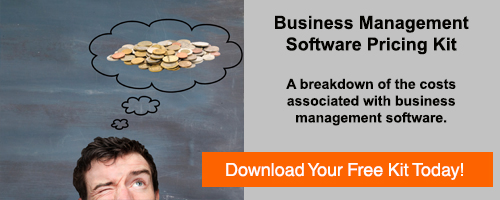With any major purchase it is good practice to evaluate reviews and speak to references whenever possible. This is especially the case with any major business purchase, such as business management software. When searching for a new system, it is best to narrow down your options to 3-6 vendors as a starting point for evaluating the software as well as the vendor itself. Certain factors, like cost and functionality are obvious areas of comparison, but you will also want to consider factors such as ongoing support, company size and customer satisfaction. The best way to evaluate customer satisfaction is to actually speak with some of the vendor’s existing customers, and while you may want to get this information during your initial discussion with each vendor, it is best to wait until a later date.
Example: Pretend that you have narrowed down your search to 6 software vendors, and each vendor provides you with information on 3 references during your initial discussion. That means that over the next several days or weeks, someone from your organization is going to have to contact and speak with no less than 18 references (assuming all are contacted). Most of these references will confirm a happy outcome and satisfaction with the vendor, and so the final result will be many hours of conversation to determine that you have correctly narrowed down your options. But is this information going to help you determine which business software is best for your company?
Even if the above scenario is a bit of an exaggeration, you get the point. You might be able to glean some useful information from speaking with references right away, but usually not enough to actually eliminate any given vendor. A faster way to find similar information is to simply spend some time searching online for vendor reviews; you can get a lot of the same information without spending as much time doing so. This can aid in a more thorough software evaluation and then actual references can be contacted at a later date.
A better way to eliminate the various business systems being considered is to perform a comprehensive evaluation process on each vendor and system in question. Although each vendor will have their own recommended process, a good strategy to follow includes:
Step 1: During the first step in narrowing down your software options, a good vendor will try to schedule an initial and short conversation in order for you and them to get an idea of scope, needs, costs etc. at a high level only. This allows each party to identify any red flags or show-stoppers right off the bat. Be wary of a vendor that jumps right into a demo of their product as the first step in the process - although software UI is an important factor to consider, it should not trump a system’s ability to meet your needs, and a vendor that understands your business and can help you achieve your goals.
Step 2: Assuming no issues are identified during Step 1, a good vendor will then schedule a more in-depth discussion to further review processes and requirements. This will provide information on existing processes and needs and the primary pain points and benefits to be addressed by a new solution. This discussion will then allow you to further narrow down your list of potential vendors and eliminate those who would not be a good fit. During this conversation it will become evident very quickly if the software being offered can meet your company’s needs. Be cautious of too many responses of “we can do that”, and find out the specifics of how certain functions will work for your business.
Step 3: The next logical step will be a demonstration of the software based on specific information gathered during Step 2. Each demo should be no longer than 1.5 hours and with no more than 2-3 vendors, in order to avoid information overload and fatigue. Make sure that before going into a demo you have outlined and discussed with each vendor a specific agenda to follow, and try to stick to that during the presentation. It can be easy to get bogged down with certain features and processes, but focus on the bigger picture and which features will be most important.
Step 4: The next step will vary based on the company in question, but is usually reserved for subsequent demos and discussions to focus on specific areas of the software, or processes that have been identified throughout the first couple of steps. By this time you should only be left with 1-2 vendors as potential options for your business. It is at this point - and while you’re also ready to receive a formal proposal from each of the vendors - that you will want to ask for Customer References.
Most software vendors will offer 3 references, and most of these references will only have good things to say about the vendor in question. However, to get a true representation of what the vendor is like to work with and how good their software is, ask instead for more references (even if you don’t actually plan on calling them all). In addition, ask for references from customers currently using the software that have had issues in the past (such as implementation or support issues). Every vendor will have customers who have been dissatisfied at some point or another: it is important to speak with these in order to understand how the vendor then addressed the issues.
Customer references are a vital step in the evaluation process of implementing business management software, but it is best to request them once you have already determined which systems will be the best fit from a functionality standpoint. Don’t waste time speaking with references if the software has not been determined to work for your company.











